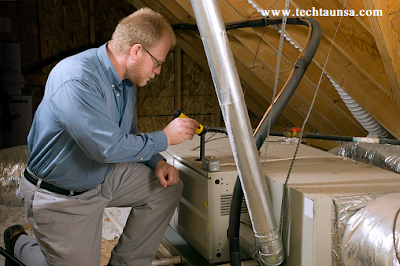Simple DIY
Method of a Furnace Duct Repair
The energy efficiency of a HVAC
system is considerably less effective when the duct system has holes. Every
particle of airflow should travel directly from the furnace to the living room
area. In some circumstances, the cost of repairing torn or broken ducts
outweighs the cost of the construction materials.
The Different
Types of HVAC Ducts
The aim of all ductwork is still
the same. Regional building regulations, on the other hand, frequently
determine the type of materials, as well as its installation method and
position. Before we go any further, make sure you're wearing the proper
personal protective equipment, such as a full face mask, safety glasses, and
gloves.
Galvanized
sheet metal
You should know the starting point
of galvanized sheet metal systems and it’s a rectangular trunk line or plenum.
The system then connects the various floors entering with routes constructed of
circular metal sheet or smaller rectangular ducts. However, S-shaped clips and
cleats keep sheet metal ducts together, as we also know them as s-locks and
drives; round sheet metal ducts are held together by screws.
Sheet metal duct is sealed using
fiber duct tape or metal sheets suitable mastic by installers. That’s why you
should know how to seal air
ducts. To avoid moisture while using air conditioning, some
solutions, such as attics or enclosed units, require insulation.
Fiberglass
duct panel
Compressing fiberglass boards with
a copper outer covering lie in this type of duct. Every joint is bound together
along with foil-backed duct tape, meshes, and ducts sealing solution. Rigid
fiberglass sheets come in thicknesses of one, 1.5, or two inches.
Flex Ducts:
This duct consists of three
layers: an innermost layer that has a link together by a spiral wire rib, a
fiberglass middle layer that offers protection from heat, and an outside layer
that works as a vapor barrier. A professional puts the inner lining over a
metal sheet cap when fixing a flex duct. He next covers the inside lining with
code-approved sealing and secures it with a duct clip, which is a huge zip tie
or worm-gear clamping. Technicians commonly recommend flex ducting of four
feet. It prevents connectors from moving away from the collars and causing
folds.
Spider
System:
A spider system feeds many branch
lines from a centralized plenum. The majority of branch lines are linked to a
boot that supplies air to the inner area. When the system requires more than one
plenum, each extra duct gets a supply from a big branch line. Mold Air Duct
Cleaning Norcross GA can be helpful if your ducts are moldy.
Energy Loss
with Duct Leaks
You must firmly seal duct networks
to keep cooled air and the power it carries. Conditioned air might escape the
ductwork before entering your interior living rooms due to connectivity issues,
holes, broken duct segments, and detached duct lines, wasting energy.
Leaks lose almost a quarter of the
air in a house. In other words, one-fourth of the cooled air in your home is
not reaching the areas. That's also comparable to duct inefficiency across the
country. Duct leakage wastes 20 to 30 percent of HVAC
energy, resulting in excessive electricity bills.
Sheet Metal
Ductwork
Galvanized sheet metal ducts are
used in many buildings in northern regions. Professionals have to place these
ducts between the floor joists. The heat that radiates from these ductwork
helps to heat the floor. Moreover, the sealer periodically weakens its grip,
allowing warm air to escape.
Leaky Seam:
Release the dangling hooks or
clamps on both sides of the repair area to reveal the leaky seam. Reduce the
duct's height to inspect the leaking junction. In most cases, more sealant is
all that you may need; nevertheless, you should totally expose big gaps and
inspect them. If a poorly placed S-lock causes the big gap then disassemble the
union and reattach it properly.
Fix the
S-lock:
To fix the S-lock, follow these
steps:
If necessary, use a pocket knife
to cut the old glue from the joint's surround. Take out any bolts that are
keeping the S-lock in position. Align the tabs on the both drives' sides and
take them out of the union. Disconnecting the joint and tension effectively
prevents total separation. Remove the old S-lock from the connection with a
screwdriver by opening the S-lock and slip it back into position. Every duct
end's smooth metal should slide into the S-lock hole formed by the screwdriver.
Use a hammer to install the drives.
Fill in the
Bigger Holes
First, evaluate the hole's length
and width after cleaning the ducts, then add one inch to both dimensions. After
that, mark those dimensions with a marker on a piece of 26-gauge metal sheet
and cut it out with metal sheet clippers. Cover the hole with the sheet metal
repair. Use a cordless screwdriver to drive a self-tapping metal sheet screw
through each end of the patch if you're fixing a sheet metal ductwork. Attach
the patch with a piece of foil tape on each end for a fiberboard duct. Lastly,
to minimize air leaks, run a bead of silicone sealant all around the borders of
the patch.
Make sure the connections are
secure and you close them with glue or foil-backed tape, and that pipes in
unconditioned rooms have insulation to enhance the productivity of your HVAC
ducting even more.
Glue the duct
connection:
Apply a 1/8-inch covering layer of
duct sealant to the connection, smearing it with a brush. Manufacturers
exclusively make the mastic for galvanized sheet metal ducts.

